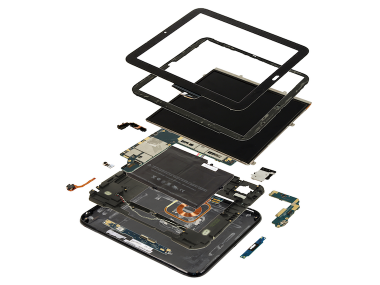By Greg Mills
The illustration is an exploded view of the HP TouchPad.
For those developers thinking about developing apps for the Palm OS, which runs on HP’s TouchPad, think a bit longer. Sales figures just are awful on HP’s latest iPad killer that isn’t. If you thought the Microsoft Kin cell phone was a success, you will really love the HP TouchPad. HP’s slogan for the TouchPad, “Like Nothing Else,” can sarcastically be interpreted by consumers as “nothing like an Apple iPad.”
The Wall Street Journal’s “All Things Digital” reports that of the 270,000 HP TouchPads Best Buy ordered, they have sold less than 25,000. Internal reports are that the 25,000 sold number does not include TouchPads that have been sold but returned for various reasons. (See http://allthingsd.com/20110816/ouchpad-best-buy-sitting-on-a-pile-of-unsold-hp-tablets/ .)
Similar stories of dismal TouchPad sales from Wal-mart, Frys and numerous other electronics retailers confirm the HP TouchPad appears to be a flop. A very expensive and embarrassing flop for HP, which is reporting quarterly sales after the markets close today. If the Palm-based touch screen tablet HP calls TouchPad fails, what of Palm? Unless HP sells smartphones that run the Palm OS, the purchase of Palm was a complete waste of US$1.2 billion.
According to the ATD story, Best Buy wants to return the mountain of unsalable TouchPads and is refusing to pay for them. Retailers have contracts that protect them from albatrosses like Microsoft Kin Phones and HP TouchPads. “Loading the sales channels” with merchandise is great when the products go out and agonizing when the sewer backs up with unsalable merchandise that cost a fortune to manufacture.
The teardown of the HP TouchPad by iSupply indicates that the baseline TouchPad costs HP roughly $306 to manufacture (see http://allthingsd.com/20110703/hps-touchpad-teardown-its-deepest-secrets-revealed/). This makes the numbers more meaningful.
If the newly discounted $399 retail price holds (and it may not hold) and Best Buy and the other electronics stores make a 40% markup or about $160 per TouchPad, HP will eat roughly $60 for each TouchPad sold and the full $306 for each TouchPad they don’t ever sell.
HP has cut the price to encourage sales to little effect, according to sources in the industry. A store named Woot dropped the sales price of the entry level TouchPad $120 and only sold 612 units. Staples virtually gave HP TouchPads away dropping $200 off the original price and still couldn’t move them. Eventually, the actual market price will be reached, but it looks like pricing HP TouchPads low enough to sell will mean HP loses money selling them at less than the cost to make them. Ouch, looks like more blood in the water for the iPad.
HP’s biggest problem is that unlike Apple, they don’t have a well developed source of latent income from TouchPads they sell. Apple sells tons of iPads and knows they will sell apps that will be loaded onto that iPad for years to come and Apple pockets 30% of the long term income. Apple will also sell music, videos and books to that iPad empowered consumer.
What will HP sell to the owners of a TouchPad? Expensive ink cartridges? Should HP stem the flow of red ink and discontinue the TouchPad line of tablets, consumers will be stuck with expensive junk and have the lesson reinforced that buying into a platform that fails is a serious mistake. This means that the other marginal platforms will also see skeptical consumers who don’t want to be stuck with junk. If you really want an iPad, buy an iPad, not a PlayBook or some other pretender.
In desperation, HP may bundle the TouchPad with laptops and hope to clear the clogged channel with back to school sales. This is hardly the vision HP had for its answer to Apple’s touch screen magic. This also supports my observation that there isn’t room in the market place for so many touch screen platforms. Though the Palm OS has merit, Android and the Apple iOS have sucked the air out of the room for also-ran platforms like Palm and RIMs proprietary OS. The jury is still out for Microsoft’s Mobile OS that might surge if Android is fragmented by Apple.
Understanding the marketplace has no room for so many platforms is why the CEO of Nokia threw up his hands and stopped wasting money on its in-house OS despite years of research and countless millions of dollars that are now wasted. Going to a platform that is going to be around when it all shakes out is the intention of both consumers and savvy developers alike.
That is Greg’s Bite out of HP’s hide for today.


